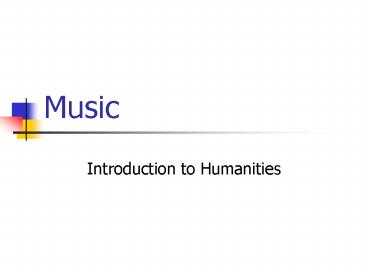Music - PowerPoint PPT Presentation
1 / 17
Title:
Music
Description:
There is no escaping the effects of music except by ... beats, just as we perceive the tempo of our heartbeat as seventy-two pulses per minute, approximately. ... – PowerPoint PPT presentation
Number of Views:34
Avg rating:3.0/5.0
Title: Music
1
Music
- Introduction to Humanities
2
Music chapter 9
- Music is one of the most powerful of the arts
partly because sounds more than any other
sensory stimulus create in us involuntary
reactions, pleasant or unpleasant. - There is no escaping the effects of music except
by turning off the source.
3
HEARERS AND LISTENERS
- Music can be experienced in two basic ways
hearing or listening. - Hearers do not attempt to perceive accurately
either the structure or the details of the form. - They hear a familiar melody which may trigger
associations to this memory.
4
Hearers and Listeners contd
- The listeners, conversely, concentrate their
attention upon the form, details as well as
structure. - Listeners focus upon the form that informs, that
creates content. - Listeners do not just listen they listen for
something the content.
5
THE ELEMENTS OF MUSIC
- First important terms and concepts of music
essential to a clear discussion. - Tone a sound that has one definite frequency or
that is dominated by one definite frequency is a
tone. - Most music is composed of a succession of tones.
6
Contd
- Consonance when two or more tones are sounded
simultaneously and the result is pleasing to the
ear, the resultant sound is said to be consonant. - For example, what sounds dissonant or unpleasant
often becomes more consonant after repeated
hearing. - Also, there is the influence of context a
combination of notes may seem dissonant in
isolation or within one set of surrounding notes
and consonant within another set.
7
Contd
- Dissonance This unpleasantness is a result of
wave interference and a phenomenon called
beating which accounts for the roughness we
perceive in dissonance. - The most powerful dissonance is achieved when
notes close to one another in pitch are sounded
simultaneously.
8
Terms Contd
- Rhythm is a term referring to the temporal
relationships of organized sounds. Rhythm marks
when a given note is to be played, and how long
it is to be played (its duration). - Our perception of rhythm in a composition is also
affected by accent or stress on given notes.
9
Terms contd
- Tempo is the speed at which a composition is
played. - We perceive tempo in terms of beats, just as we
perceive the tempo of our heartbeat as
seventy-two pulses per minute, approximately. - Many tempos have descriptive names indicating the
general time value.
10
Terms contd
- Melody is usually defined as a group of notes
played one after another having a perceivable
shape, or having a perceivable beginning, middle,
and end. - Usually a melody is easily recognizable when
replayed. - We not only recognize melodies easily but can say
a great deal about them.
11
Terms contd
- Counterpoint by staggering the melodic lines as
in folk songs such as Row, Row, Row Your Boat,
this is called counterpoint - A playing of one or more motives, themes, or
melodies against each other. - It implies an independence of simultaneous
melodic lines, each of which can, at times, be
most clearly audible.
12
Terms contd
- Harmony is the sounding of tones simultaneously.
- It is the vertical dimension, as with a chord
(fig 9-2) as opposed to the horizontal dimension,
with a melody. - A chord is a group of notes sounded together that
has a specific relationship to a given key the
chord C-E-G, for example, is a major triad in the
key of C major.
13
Terms contd
- Dynamics one of the most easily perceived
elements of music is dynamics loudness and
softness. - Composers explore dynamics as they explore
keys, timbres, melodies, rhythms, and harmonic
to achieve variety, to establish a pattern
against which they can play, build tension and
release it, and to provide the surprise which can
delight an audience.
14
THE SUBJECT MATTER OF MUSIC
- Our theory identifies two basic kinds of subject
matter feeling (emotions, passions, and moods)
and sound. - It is difficult for music to refer to specific
objects and events outside itself. - Therefore it is difficult to think of music as
having the same kind of subject matter as a
representational painting, a figurative
sculpture, or a realistic novel.
15
FEELINGS
- The content of music is the interpretation of
those feelings. - Feelings are composed basically of sensations,
emotions, passions, and moods. - Any awareness of our sense organs, whether
internal or external being stimulated is a
sensation.
16
Contd
- Emotions are strong sensations felt as related to
a specific and apparent stimulus. - Passions are emotions elevated to great
intensity. - Moods, on the other hand, are sensations that
arise from no specific or apparent stimulus, as
when one awakens with a feeling or lassitude or
gloom.
17
Brief Summary
- Music with its capacity to evoke feelings, and
with a complexity of detail and structure that in
many ways is greater than that of language, may
be able to reveal or interpret feeling with much
more precision than language. - There is mystery about music, unique among the
arts that is part of its fascination.































